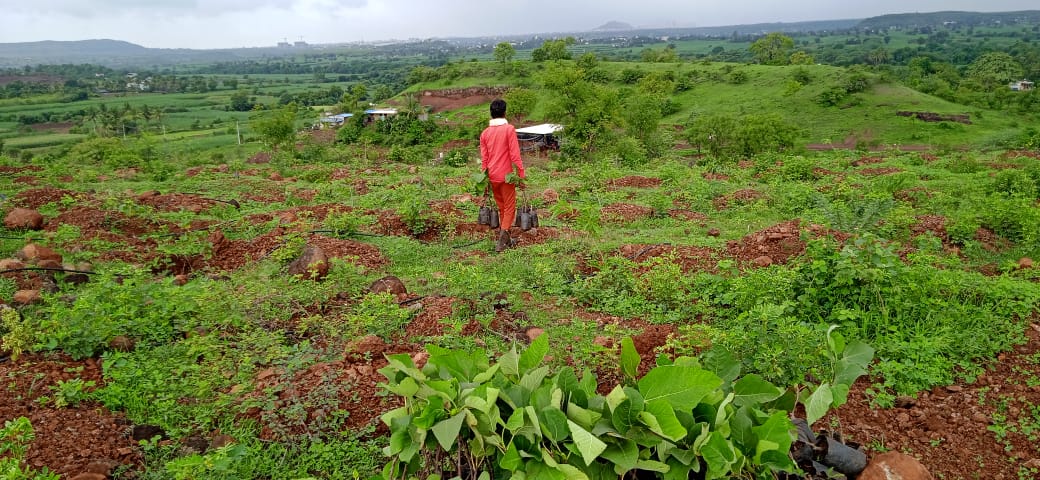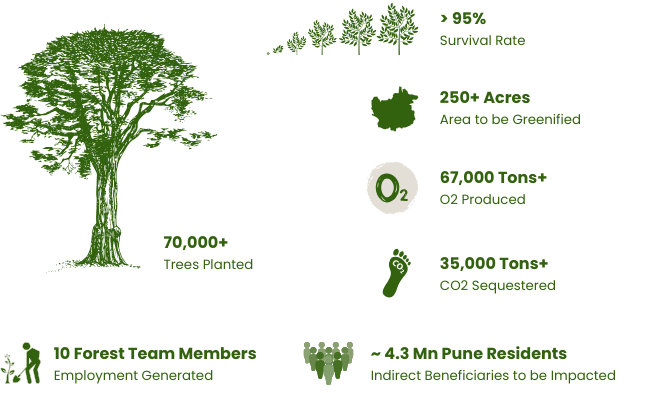A Case Study on Indrayani Riverside Forest, Developed by SankalpTaru Foundation
Plantation Model
Barren Community Land Transformation Program

Corporate Sponsors
MindTree, Global Logic, Vivek & Vandana Foundation, Salesforce, Skechers, Microsoft, Hapag-Lloyd, Allianz, EClerx, Watson, Accenture, Rentokil PCI, NTT Data, Saama Foundation, Quest Global, CSel, PNB Metlife, SBI, HDBFS.
Introduction
The Indrayani River, which has its source in Kurvande village near Lonavala in the Pune district of Maharashtra, faces significant ecological threats due to anthropogenic activities. These activities include rampant stone mining, overfishing, discharge of pollutants, and deforestation, which collectively contribute to siltation and degradation of the river’s ecosystem. The ongoing issue of quarries in Wagholi, Maharashtra, highlights the critical concern of air pollution from nearby mining operations. Specifically, this excessive mining activity, occurring in proximity to a plantation block, raises serious concerns.
These mining activities not only deplete minerals and soil from the land but also exert detrimental effects on the Air Quality Index (AQI) across the entire region, primarily due to the emission of dust particles containing particulate matter, including PM2.5 and PM10 which is known to have adverse health effects. These tiny particles can penetrate deep into the respiratory system, leading to respiratory illnesses, exacerbation of pre-existing conditions, and decreased overall air quality.
The urgency of addressing the adverse impacts of mining on air quality needs to be prioritized, as residents have been subjected to severe air pollution, with complaints of smoke engulfing the area.


Thus, to mitigate and restore the ecological balance between the Indrayani River and its surrounding environment, SankalpTaru Foundation has undertaken a proactive reforestation initiative. The project is situated on the Panchayat land of Tulapur village, located in Pune, Maharashtra.
This reforestation effort aligns with the principles of ecosystem restoration and biodiversity conservation, aiming to enhance the resilience and sustainability of the Indrayani River’s ecosystem by reintroducing native vegetation and curbing the detrimental effects of invasive species which is an important factor in safeguarding the overall health and functionality of freshwater ecosystems.
Pre-Plantation Activities
- Site Preparation: In preparation for plantation activities, a comprehensive site clearance procedure was executed. This process involved the removal of invasive species, Gliricidia sepium. This species, although being a leguminous plant (promotes nitrogen-fixation in soil), can significantly hinder the growth and development of native flora in their proximity due to competition for resources and disrupt the ecosystem balance. Soil analysis was conducted, and necessary actions were implemented to rectify and enhance the soil’s properties.


- Fencing: To safeguard the newly planted saplings from grazing and other animal menaces, a systematic fencing system was implemented around the plantation blocks to prevent herbivore damage and promote successful afforestation.
- Water Pond for Storage: A water tank with a substantial capacity of 2,000 gallons was installed to facilitate efficient irrigation practices ensuring optimal plant growth and productivity.


- Solar Panel Installation: The installation of solar PV panel based generation units, comprising 6 kW and 7 kW, align with SankalpTaru’s aim to utilize the latest advancements in sustainable agriculture. These solar powered generation units run irrigation systems and hence making the operations sustainable. The integration of solar power for agricultural activities reduces greenhouse gas emissions and minimizes dependence on non-renewable energy sources (UNEP, 2020).
- Resource Efficient Irrigation: The implementation of a solar-powered micro-drip irrigation system underscores SankalpTaru’s commitment to resource efficiency. The benefits of drip irrigation, such as precise water application and reduced water wastage, lead to improved plant survival rate and conservation of water resources.


- Pit Digging: Pit digging aligned with drip lines has been carried out to ensure precise planting and irrigation of saplings. This practice promotes uniform root zone wetting, which is crucial for the establishment and growth of young tree saplings. SankalpTaru employs an innovative pit digging technique to retain water within plant basins. These pits are typically larger and deeper than traditional planting holes and are designed with specific water harvesting features. One critical element is a berm or bund constructed on the downhill side of the pit which acts as a barrier to slow down and capture rainwater runoff. Pits are dug along the contour lines of the slope, helping to intercept and retain rainwater as it flows downhill, creating a series of small basins that collect and store water. After planting the tree, a layer of mulch is applied around it for reducing evaporation and retaining soil moisture. Due to the plantation site being a rocky terrain the presence of rocks in the soil is used to advantage by using them as natural barriers to control erosion, aid in water retention and stabilize the soil. The slope of the terrain is carefully considered during the pit digging process. The pits are strategically placed so that they can intercept and hold rainwater, preventing it from quickly running downhill. This ensures that water is available to nourish the planted trees over an extended period.


Onground Plantation
The onground plantation initiative has successfully cultivated approximately 70,000+ trees, achieving an impressive survival rate exceeding 95%.
The planted tree species encompass a diverse array, featuring ecologically significant varieties, some of which are listed below.
| Sl. No. | Species | Common Name |
| 1 | Ficus religiosa | Peepal |
| 2 | Azadirachta indica | Neem |
| 3 | Ficus benghalensis | Banyan |
| 4 | Syzygium cumini | Jamun |
| 5 | Dalbergia sissoo | Shisham |
| 6 | Pterocarpus santalinus | Lal Chandan |
| 7 | Pongamia pinnata | Karanj |
| 8 | Tamarindus indica | Imli |
| 9 | Swietenia mahagoni | Mahogany |
| 10 | Mangifera indica | Mango |
| 11 | Prunus dulcis | Badam |
| 12 | Anacardium occidentale | Kaju |
| 13 | Annona squamosa | Custard Apple |






Post Plantation Monitoring
To maximize the sapling survival rate and promote robust growth, our dedicated team of approximately 10 members conducts continuous monitoring and maintenance at the plantation site.
- 24/7 Site Surveillance: Continuous surveillance is carried out to monitor environmental conditions that may impact sapling health. This includes factors such as temperature, humidity, and weeding, which are analyzed to optimize plant growth.
- Water management: To ensure optimal hydration for the saplings, our team meticulously maintains and operates water motors. The amount of water administered is carefully calibrated based on the specific water requirements of the plant species, considering factors like soil moisture levels and evapotranspiration rates.
- Pest and Disease Management: SankalpTaru’s approach to pest control and disease management is rooted in scientific research. We employ integrated pest management (IPM) strategies that rely on biological control agents, plant resistance mechanisms, and targeted pesticide application only when necessary. Monitoring for pests and diseases is conducted through site surveys and data collection to inform precise interventions.




Challenges & Mitigation
The biggest challenge encountered during the reforestation project was posed by the invasive species Gliricidia sepium in the project area which impacted the ecosystem.
- Soil Degradation: Gliricidia sepium has been documented to have allelopathic effects on the soil, releasing chemicals that can inhibit the growth of other plants leading to a decline in soil quality and productivity.
- Toxic Leaf Litter: Scientific studies have confirmed that Gliricidia sepium leaves contain toxic compounds, such as tannins, which can further exacerbate soil toxicity and inhibit the growth of native plant species. This toxic leaf litter can also negatively affect soil microorganisms.
- Competition with Natives: Gliricidia sepium competes aggressively with native plant species for resources, including water, nutrients, and light which could result in the displacement and decline of native trees in the vicinity.
- Rocky and Undulating Terrain: The rocky and uneven terrain posed challenges for resource movement and pit digging making it difficult to transport equipment, saplings, and other necessary resources uphill. Digging pits in rocky soil is more labor-intensive and time-consuming than in softer soil.
- Presence of Stray Cattle: Stray cattle damages newly planted saplings by grazing on them or trampling over them. Protecting the young trees from these animals required fencing and monitoring efforts, which added to the overall cost and labor involved in tree planting.
- Active Land Mafias: The presence of land mafias causes obstacles to environmental conservation efforts. Dealing with land mafias involves negotiations, or finding ways to protect and reclaim land for tree planting, which can be a complex and time-consuming process.
To address these challenges SankalpTaru implemented a systematic approach:
- Thorough Land Clearance: A rigorous land clearance process was undertaken to eradicate Gliricidia sepium from the project site.
- Soil Quality Enhancement: After the removal of the species, soil quality improvement measures were employed based on soil analysis. This included amendments to rectify soil toxicity and enhance nutrient availability, ensuring a favorable environment for the growth of native trees.
- Collaborating with local authorities to combat land mafias.
By aligning our efforts with study on invasive species and soil health, we aimed to mitigate the negative impacts of Gliricidia sepium and create a conducive environment for the successful establishment of native tree species in our reforestation project.
Socio-Environmental Impact
This reforestation project holds significant ecological promise, sustaining the river’s ecosystem and mitigating the adverse effects of anthropogenic pressures on biotic components and aquatic species.
- Direct Impact on Aquatic Environment: By restoring vegetation along the riverbanks, we are directly impacting the aquatic environment. The presence of riparian vegetation helps improve water quality by filtering pollutants and stabilizing riverbanks, benefiting aquatic species.
- Wildlife Corridor: The plantation area creates a crucial terrestrial wildlife corridor which will play a vital role as a fragmented habitat while also strengthening the regional biodiversity.
- Direct Impact on Soil Erosion and Groundwater Quality: Deforestation, siltation, and sand mining contribute to soil erosion. The trees will serve as a vital shield against extensive soil erosion while their root systems will facilitate groundwater replenishment and act as a natural filtration system, diminishing soil pollution stemming from the leaching of commercial fertilizers and industrial wastes.
- Carbon Sequestration: This reforestation initiative will not only contribute to environmental restoration but will also act as a massive carbon sink, enhancing the carbon sequestration capacity. This holds the potential to improve the air quality by increasing the city’s green cover, and positively impacting the health and well-being of approximately 4.3 million residents in Pune.

Conclusion
The reforestation project undertaken by SankalpTaru Foundation is a testament to the power of collective action in addressing critical environmental challenges. The project’s success in cultivating over 70,000 trees with a survival rate exceeding 95% is a remarkable achievement.
The restoration of this vital ecosystem along the Indrayani River holds immense ecological promise. It serves as a buffer against the adverse impacts of rampant mining, deforestation, and pollution, thereby safeguarding the health of the river and its surrounding environment. The project not only benefits aquatic species through improved water quality and stability but also establishes a terrestrial wildlife corridor that enhances regional biodiversity.
As we move forward, it is essential to continue monitoring and maintaining the plantation site to ensure the long-term sustainability of this ecosystem restoration initiative. The outcome from this project can serve as a valuable model for similar reforestation efforts in other regions facing ecological threats.
The Indrayani Riverside Forest Forest Reforestation Project is not simply about planting trees; it is about revitalizing an entire ecosystem, enhancing biodiversity, mitigating climate change, and improving the quality of life for the community.









References
- Dighavkar, P. (2016). A Study of an Ecological Pathological and Bio-Chemical Impact of Urbanisation and Industrialisation on Water Pollution of Bhima River and its Tributaries Pune Districts, Maharashtra, India. Tilak Maharashtra Vidyapeeth, Pune, India.
- Kurane, A., and Samant, J. (2012). “Eco-restoration potential in the degraded watershed areas of the western ghats”. Proceeding of International Conference- SWRDM
- Suding, K. et. al. (2015). “Committing to ecological restoration.” Science, 348(6235), 638-640.
- UNEP (2020). “Advancing Sustainable Agriculture.” United Nations Environment Programme. https://www.unep.org/resources/advancing-sustainable-agriculture

